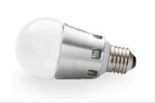Feb 20 2008
When choosing the greenest option for lighting your home or office, look to the new light emitting diode (LED) light bulbs as the next generation green alternative. Currently, compact fluorescent bulbs (CFL) get attention as a lower-energy bulb than traditional incandescent bulbs, and, according to the Wall Street Journal, there has been a 300% increase in sales of CFLs over the past two years. However, new LED bulbs are on the rise as the green bulbs of the future and the replacement for CFLs.
LED applications were previously available only for industrial and office use such as traffic lights, office building lighting, and colour panels at high prices. Now screw-in bulbs that fit into standard fittings have recently become available to the consumer for use in residential and professional settings.
 The Pharox LED Lightbulb.
The Pharox LED Lightbulb.
The newly-introduced Pharox bulb from Lemnis Lighting uses only four watts of energy compared to seven watts used by a CFL bulb, and emits 2.69 kg of CO2 compared to 4.70 kg emitted by a CFL bulb. Available at http://www.upscalelighting.com, the Pharox bulb contains no mercury so it is entirely recyclable, lasts for 35 years (at 4 hours a day) or 50,000 hours, does not get hot, and emits a soft warm glow.
In contrast, CFL bulbs have a relatively short life span of only 8,000 hours and are not recyclable because they contain mercury that is harmful to the environment. While better than incandescent bulbs, CFLs are no longer the greenest option for residential and professional lighting.
"The Pharox brings new technology to LED lighting, including one chip, high lumens and good heat dissipation, which results in our ultra-efficient, warm white light with no flicker or delayed start up time," said Frans Otten, chairman of Lemnis Lighting.
If one percent of the earth's population were to replace just two incandescent bulbs to Pharox bulbs each, then we would save about:
- 6.3 billion KWh of energy
- 100 million tons in CO2 emissions
- $35 billion in usage/replacement costs.